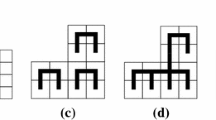Abstract
Working in a three-dimensional variant of Winfree’s abstract Tile Assembly Model, we show that, for all \(N \in \mathbb {N}\), there is a tile set that uniquely self-assembles into an \(N \times N\) square shape at temperature 1 with program-size complexity of \(O\left( \frac{\log N}{\log \log N}\right) \) (the program-size complexity, also known as tile complexity, of a shape is the minimum number of unique tile types required to uniquely self-assemble it). Note that this tile complexity is optimal for all algorithmically random values of N. Moreover, our construction is “just barely” 3D in the sense that it works even when the placement of tiles is restricted to the \(z = 0\) and \(z = 1\) planes. This result affirmatively answers an open question from Cook et al. (SODA 2011). To achieve this result, we develop a general 3D temperature 1 optimal encoding construction, reminiscent of the 2D temperature 2 optimal encoding construction of Soloveichik and Winfree (SIAM J Comput 36(6):1544–1569, 2007), and perhaps of independent interest. We also develop a more sophisticated 3D temperature 1 optimal encoding construction that places asymptotically fewer tiles than our original optimal encoding construction. We use the method of conditional determinism of Lutz and Shutters (Theory Comput Syst 51(3):372–400, 2012) to prove the correctness of our constructions.
















































Similar content being viewed by others
Notes
Technically, Rothemund and Winfree established the 2D self-assembly case, but their proof easily generalizes to 3D self-assembly.
One subtle difference between our 3D definition of K and the original 2D definition of the tile complexity of an \(N \times N\) square, given by Rothemund and Winfree [12], is that they assume a fully-connected final structure, whereas we do not.
Our construction is different from the one described in [5]. That paper describes a general procedure for converting any 2D temperature 2 zig-zag tile system into a 3D temperature 1 tile system. For example, one difference is in the scaling factor in the vertical dimension, that is, how many rows of tiles are needed in the temperature 1 tile system to represent a single increment row or copy row in the temperature 2 tile system. In our construction, this scaling factor is equal to 2, while it is equal to 4 in the conversion procedure described in [5]. Of course, our construction only produces binary counters and does not apply to any other zig-zag tile system.
References
Adleman, L.M., Cheng, Q., Goel, A., Huang, M.-D.A.: Running time and program size for self-assembled squares. In: STOC, pp. 740–748 (2001)
Cannon, S., Demaine, E.D., Demaine, M.L., Eisenstat, S., Patitz, M.J., Schweller, R., Summers, S.M., Winslow, A.: Two hands are better than one (up to constant factors). In: Proceedings of the Thirtieenth International Symposium on Theoretical Aspects of Computer Science, pp. 172–184 (2013)
Chen, H.-L., Doty, D.: Parallelism and time in hierarchical self-assembly. In: SODA 2012: Proceedings of the 23rd Annual ACM-SIAM Symposium on Discrete Algorithms, SIAM, pp. 1163–1182 (2012)
Cheng, Q., Aggarwal, G., Goldwasser, M.H., Kao, M.-Y., Schweller, Robert T., de Espanés, Pablo Moisset: Complexities for generalized models of self-assembly. SIAM J. Comput. 34, 1493–1515 (2005)
Cook, M. , Fu, Y., Schweller, R.T.: Temperature 1 self-assembly: deterministic assembly in 3D and probabilistic assembly in 2D. In:SODA 2011: Proceedings of the 22nd Annual ACM-SIAM Symposium on Discrete Algorithms, SIAM (2011)
Doty, D., Patitz, M.J., Summers, S.M.: Limitations of self-assembly at temperature 1. Theoret. Comput. Sci. 412, 145–158 (2011)
Li, M., Vitányi, P.: An Introduction to Kolmogorov Complexity and its Applications, 3rd edn. Springer, New York (2008)
Luhrs, C.: Polyomino-safe DNA self-assembly via block replacement. In: Goel, A., Simmel, F.C., Sosík, P. (eds), DNA14. Lecture Notes in Computer Science, vol. 5347, Springer, pp. 112–126 (2008)
Lutz, J.H., Shutters, B.: Approximate self-assembly of the sierpinski triangle. Theory Comput. Syst. 51(3), 372–400 (2012)
Manuch, J., Stacho, L., Stoll, C.: Two lower bounds for self-assemblies at temperature 1. J. Comput. Biol. 17(6), 841–852 (2010)
Presburger, M.: Über die vollständigkeit eines gewissen systems der arithmetik ganzer zahlen, welchem die addition als einzige operation hervortritt, pp. 92–101. Warsaw, Compte-rendus du premier Congrès des Mathématiciens des pays Slaves (1930)
Rothemund, P.W.K., Winfree, E.: The program-size complexity of self-assembled squares (extended abstract). In: STOC ’00: Proceedings of the Thirty-Second Annual ACM Symposium on Theory of Computing, pp. 459–468 (2000)
Soloveichik, D., Winfree, E.: Complexity of self-assembled shapes. SIAM J. Comput. 36(6), 1544–1569 (2007)
Wang, H.: Proving theorems by pattern recognition—II. Bell Syst. Tech. J. XL(1), 1–41 (1961)
Winfree, E.: Algorithmic self-assembly of DNA, Ph.D. thesis, California Institute of Technology, June (1998)
Acknowledgments
We thank John Broughton for thoroughly reviewing an early version of this paper as well as for writing a computer program that implements our main construction. We also thank Robert Schweller for suggesting the problem of doing optimal encoding using fewer tile placements. Finally, we thank the anonymous referees, whose detailed comments helped improve the final version of the paper.
Author information
Authors and Affiliations
Corresponding author
Additional information
An earlier version of this paper was published in the proceedings of the Twenty first International Conference on DNA Computing and Molecular Programming (DNA21).
This author’s research was supported in part by the Faculty Development Program at the University of Wisconsin–Oshkosh (Grants FDR881 and FDW852).
Rights and permissions
About this article
Cite this article
Furcy, D., Micka, S. & Summers, S.M. Optimal Program-Size Complexity for Self-Assembled Squares at Temperature 1 in 3D. Algorithmica 77, 1240–1282 (2017). https://doi.org/10.1007/s00453-016-0147-6
Received:
Accepted:
Published:
Issue Date:
DOI: https://doi.org/10.1007/s00453-016-0147-6




